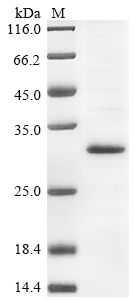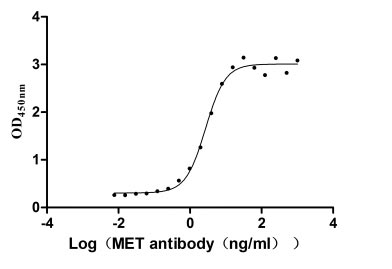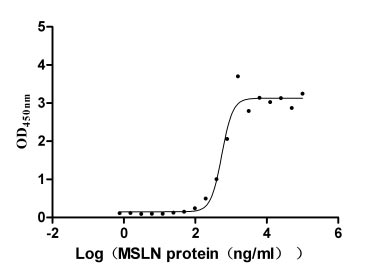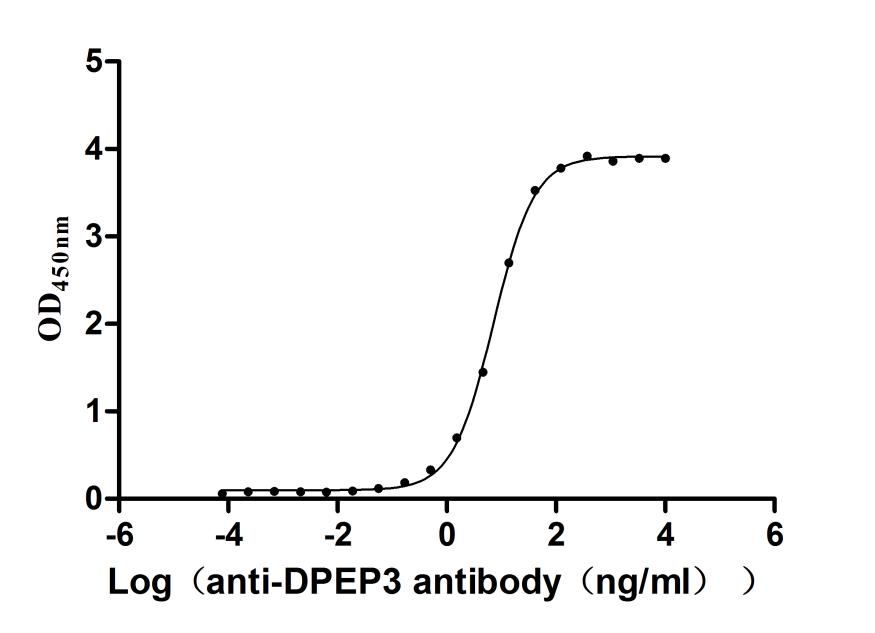Recombinant Rat Transforming growth factor beta-1 proprotein (Tgfb1), partial
-
货号:CSB-BP023446RA
-
规格:¥3168
-
图片:
-
其他:
产品详情
-
纯度:Greater than 85% as determined by SDS-PAGE.
-
基因名:
-
Uniprot No.:
-
别名:Tgfb1; Transforming growth factor beta-1 proprotein [Cleaved into: Latency-associated peptide; LAP); Transforming growth factor beta-1; TGF-beta-1)]
-
种属:Rattus norvegicus (Rat)
-
蛋白长度:Partial
-
来源:Baculovirus
-
分子量:29.6 kDa
-
表达区域:30-278aa
-
氨基酸序列LSTCKTIDMELVKRKRIEAIRGQILSKLRLASPPSQGEVPPGPLPEAVLALYNSTRDRVAGESADPEPEPEADYYAKEVTRVLMVDRNNAIYDKTKDITHSIYMFFNTSDIREAVPEPPLLSRAELRLQRFKSTVEQHVELYQKYSNNSWRYLGNRLLTPTDTPEWLSFDVTGVVRQWLNQGDGIQGFRFSAHCSCDSKDNVLHVEINGISPKRRGDLGTIHDMNRPFLLLMATPLERAQHLHSSRHRR
Note: The complete sequence including tag sequence, target protein sequence and linker sequence could be provided upon request. -
蛋白标签:N-terminal 6xHis-tagged
-
产品提供形式:Liquid or Lyophilized powder
Note: We will preferentially ship the format that we have in stock, however, if you have any special requirement for the format, please remark your requirement when placing the order, we will prepare according to your demand. -
缓冲液:Tris-based buffer,50% glycerol
-
储存条件:Store at -20°C/-80°C upon receipt, aliquoting is necessary for mutiple use. Avoid repeated freeze-thaw cycles.
-
保质期:The shelf life is related to many factors, storage state, buffer ingredients, storage temperature and the stability of the protein itself.
Generally, the shelf life of liquid form is 6 months at -20°C/-80°C. The shelf life of lyophilized form is 12 months at -20°C/-80°C. -
货期:Basically, we can dispatch the products out in 1-3 working days after receiving your orders. Delivery time may differ from different purchasing way or location, please kindly consult your local distributors for specific delivery time.Note: All of our proteins are default shipped with normal blue ice packs, if you request to ship with dry ice, please communicate with us in advance and extra fees will be charged.
-
注意事项:Repeated freezing and thawing is not recommended. Store working aliquots at 4°C for up to one week.
-
Datasheet & COA:Please contact us to get it.
相关产品
靶点详情
-
功能:Transforming growth factor beta-1 proprotein: Precursor of the Latency-associated peptide (LAP) and Transforming growth factor beta-1 (TGF-beta-1) chains, which constitute the regulatory and active subunit of TGF-beta-1, respectively.; Required to maintain the Transforming growth factor beta-1 (TGF-beta-1) chain in a latent state during storage in extracellular matrix. Associates non-covalently with TGF-beta-1 and regulates its activation via interaction with 'milieu molecules', such as LTBP1, LRRC32/GARP and LRRC33/NRROS, that control activation of TGF-beta-1. Interaction with LRRC33/NRROS regulates activation of TGF-beta-1 in macrophages and microglia. Interaction with LRRC32/GARP controls activation of TGF-beta-1 on the surface of activated regulatory T-cells (Tregs). Interaction with integrins (ITGAV:ITGB6 or ITGAV:ITGB8) results in distortion of the Latency-associated peptide chain and subsequent release of the active TGF-beta-1.; Multifunctional protein that regulates the growth and differentiation of various cell types and is involved in various processes, such as normal development, immune function, microglia function and responses to neurodegeneration. Activation into mature form follows different steps: following cleavage of the proprotein in the Golgi apparatus, Latency-associated peptide (LAP) and Transforming growth factor beta-1 (TGF-beta-1) chains remain non-covalently linked rendering TGF-beta-1 inactive during storage in extracellular matrix. At the same time, LAP chain interacts with 'milieu molecules', such as LTBP1, LRRC32/GARP and LRRC33/NRROS that control activation of TGF-beta-1 and maintain it in a latent state during storage in extracellular milieus. TGF-beta-1 is released from LAP by integrins (ITGAV:ITGB6 or ITGAV:ITGB8): integrin-binding to LAP stabilizes an alternative conformation of the LAP bowtie tail and results in distortion of the LAP chain and subsequent release of the active TGF-beta-1. Once activated following release of LAP, TGF-beta-1 acts by binding to TGF-beta receptors (TGFBR1 and TGFBR2), which transduce signal. While expressed by many cells types, TGF-beta-1 only has a very localized range of action within cell environment thanks to fine regulation of its activation by Latency-associated peptide chain (LAP) and 'milieu molecules'. Plays an important role in bone remodeling: acts as a potent stimulator of osteoblastic bone formation, causing chemotaxis, proliferation and differentiation in committed osteoblasts. Can promote either T-helper 17 cells (Th17) or regulatory T-cells (Treg) lineage differentiation in a concentration-dependent manner. At high concentrations, leads to FOXP3-mediated suppression of RORC and down-regulation of IL-17 expression, favoring Treg cell development. At low concentrations in concert with IL-6 and IL-21, leads to expression of the IL-17 and IL-23 receptors, favoring differentiation to Th17 cells. Stimulates sustained production of collagen through the activation of CREB3L1 by regulated intramembrane proteolysis (RIP). Mediates SMAD2/3 activation by inducing its phosphorylation and subsequent translocation to the nucleus. Can induce epithelial-to-mesenchymal transition (EMT) and cell migration in various cell types.
-
基因功能参考文献:
- High TGFB1 expression is associated with glomerular mesangial cell hypertrophy. PMID: 29397070
- High TGFB1 expression is associated with liver fibrosis. PMID: 30243650
- In the present study, we assessed the effect of boldine on the progression of kidney disease using the 2K1C hypertension model and identifying mediators in the RAS, such as TGF-β, that could be modulated by this alkaloid PMID: 29941815
- Ang II induced epithelial-mesenchymal transition in renal tubular epithelial cells via Tgfb1. PMID: 29746862
- LET suppression promoted BMSCs proliferation by up-regulating the expression of TGF-beta1 and activating Wnt/beta-catenin pathway. PMID: 29068476
- These findings implicate TGFbeta1 as one of the important factors impairing drug induced CYP induction in co-cultures and suggests that caution needs to be exercised in the use of hepatocyte-fibroblast co-cultures for CYP induction studies. PMID: 29366910
- This suggests that MG53 is a potential regulator of atrial fibrosis induced by the TGF-beta1/Smad pathway in patients with atrial fibrillation . PMID: 29233682
- This suggests that soybean isoflavones could delay the process of renal interstitial fibrosis in DN rats by decreasing the expression of Wnt4, beta-catenin and TGF-beta1 in the renal interstitium, thus demonstrating that soybean isoflavones plus losartan have the best protective effects against diabetes-induced renal fibrosis. PMID: 29921370
- The results of our study suggest that miR-142 inhibits proliferation and promotes apoptosis in ASMCs during airway remodeling in asthmatic rats by inhibiting TGF-beta expression via a mechanism involving the EGFR signaling pathway. PMID: 29949788
- In cultured hippocampal neurons, TGF-[beta]1 prevented A[beta]1-42-induced APP, TNF-[alpha], Bax, cleaved caspase-3, and cleaved caspase-9 expression upregulation, and cell apoptosis, showing a neuroprotective effect of TGF-[beta]1. Silencing of the T[beta]R1 gene abolished the neuroprotective effect of TGF-[beta]1. PMID: 29200096
- Acetyl-11-Keto-beta-Boswellic Acid is able to attenuate oxidative stress and profibrotic mechanisms, and improve vascular remodeling in hypertension through TGF-beta1/Smad3 pathway. PMID: 28009003
- the truncated variant of gHGF (a double mutant of N-terminal hairpin and first kringle domains of gHGF, K132E and G134E, gmNK1) protein fused with His6 tag, the molecular weight of which was about 20.0kDa, which was expressed in Escherichia coli BL21 (DE3) and purified with Ni(2+)-affinity chromatography.gmNK1 inhibited protein expression levels of fibrosis-related Col I and alpha-SMA in TGF-beta1-activated HSC-T6 cells PMID: 28837849
- The results suggest that the CIP4/Par6 complex plays an important role in the occurrence of epithelial-mesenchymal transition in TGF-beta1-stimulated epithelial kidney cells. PMID: 28848997
- calcitonin and TGF-beta have roles in cartilage degeneration and nociception in an experimental rat model of osteoarthritis PMID: 27345362
- Suggest a potentially mutual regulation between IGFBPrP1 and TGFbeta1, which activates hepatic stellate cells and extracellular matrix deposition. PMID: 28823370
- Study demonstrated that the activation of transforming growth factor-beta1 (TGF-beta1) in mild traumatic brain injury (mTBI) correlated with the induction of free radical generating enzyme NADPH oxidase 1 (NOX1). Study study could establish the significance of TGF-beta1 in transforming the pathophysiology of mTBI into secondary injury. PMID: 28433746
- TGF-Beta1 (and Egr-1) are up-regulated by sustained hyperosmolarity in the renal medulla. PMID: 28673338
- The positive correlation between Reg1a and Tgfb1 genes expression was determined in the dynamics of stress-induced gastric lesions development and healing, which may indicate the involvement of Tgfb1 in acceleration of lesions healing. PMID: 29537200
- In conclusion, PFD and Collagen-PVP decrease inflammation, fibrosis, TGFbeta-1 expression, and CD in the posttracheoplasty rats' scar. PMID: 28584818
- TGFB1-expressing mesenchymal stem cells induce local tolerance in a rat liver transplantation model of acute rejection. PMID: 27333806
- In the present study, isolated rat peritoneal mesothelial cells were treated with TGF-beta1 and/or IL-6 which elicited mesenchymal transition (MMT) as determined by morphologic and biochemical techniques ..Partial characterization of relevant signaling pathways identified Erk1/2 activation, which was enhanced by combined TGF-b1/IL-6 administration, as a crucial necessary factor in the transition.. PMID: 26825317
- miR-497 could suppress TGFbeta1-induced pulmonary fibroblast proliferation and EIF3A, Collagen I and alpha-SMA protein levels. PMID: 28322466
- could prevent cardiac fibroblasts from activation into myofibroblast and protect HUVEC against endothelial to mesenchymal transition. These effects may be mediated by inhibition of the TGFbeta pathway in both cardiac fibroblasts and HUVECs. PMID: 28303407
- Administration of Methylglyoxal led to depletion of antioxidant enzymes, induction of fibrosis (p < 0.001), up-regulated expression of RAGE (3.5 fold), TGF-beta (4.4 fold), SMAD2 (3.7 fold), SMAD3 (6.0 fold), IL-6 (4.3 fold) and TNF-alpha (5.5 fold) in the heart tissues compared to control rats. PMID: 28091942
- High TGFB1 expression is associated with pulmonary arterial hypertension. PMID: 29069575
- Data suggest that white adipose tissues in various sites respond differently to distinct diet patterns regarding Tgfb expression and signaling pathways; here, energy-restricted and fat-restricted diet containing fish oil down-regulates expression of Tgfb in mesenteric adipose tissue and up-regulates expression of Tgfb in retroperitoneal adipose tissue. PMID: 27736730
- Brd4 inhibition attenuates unilateral ureteral obstruction-induced fibrosis by blocking TGF-beta-mediated Nox4 expression. PMID: 28063381
- Transforming growth factor beta 1 overexpression observably activated these two pathways, suggesting that Transforming growth factor beta 1 might participate in the modulation of vitamin D through regulating ERK and JNK pathways in Bone marrow-derived mesenchymal stem cells. PMID: 28817810
- The data suggest that miR-155 plays a role in mediating TGF-beta1-induced podocyte injury via nephrin, desmin and caspase-9. PMID: 28719898
- This paper provides evidence that TGF-beta stimulates prolonged EGFR transactivation, which is dependent on c-Src tyrosine kinase (Src). PMID: 28943431
- Although TGF-beta promotes circulating regulatory T cells (Tregs)in female spontaneously hypertensive rats (SHR), it does not account for the sex difference in renal Tregs in SHR. PMID: 28679591
- Mesenchymal stem cells could inhibit the process of chronic rejection of small intestine transplant. The mechanisms may include the inhibited function of these cells on lymphocyte proliferation, reduced infiltration of macrophages, and reduced expression of transforming growth factor beta1 and platelet-derived growth factor C. PMID: 28338461
- this study shows that FTY720 attenuates renal fibrosis by TGF-beta signaling in fibroblasts PMID: 28658504
- Apigenin ameliorated renal damage due to diabetic nephropathy by suppressing oxidative stress and fibrosis via MAPK-NF-kappaB-TNF-alpha and TGF-beta1-MAPK-fibronectin pathways. PMID: 28566504
- High glucose stress suppresses SnoN while activating TGF-beta1 and Rnf111 (Arkadia) in renal tubular epithelial cells and diabetic rats. PMID: 28350874
- The fibromodulin (Fm)-transforming growth factor (TGF)-beta1 nexus plays a crucial in fetal-type scarless skin repair. PMID: 27665369
- mRNA/protein levels are increased in kidney remnants from 5/6 nephrectomized rats and strongly correlate with TGF-beta1 expression. PMID: 27714812
- Data indicate transforming growth factor beta (TGFbeta) involvement in early activation of platelet-derived growth factor receptor beta (PDGFRbeta)+ pericytes in aristolochic acid induced acute kidney injury. PMID: 27379382
- TGFbeta1 is involved in cholangiocarcinoma tumor progression and participates through miR-34a mediated downstream signaling cascades. PMID: 27364974
- In high glucose-treated glomerular mesangial cells, TGR5 can suppress the NF-kappaB-mediated upregulation of fibronectin and TGF-beta1 by inhibiting RhoA/ROCK signaling via protein kinase A. PMID: 27470217
- this study shows that TGF-beta1 vaccine attenuated diabetic nephropathy in OLETF rats through reduction of inflammation, improvement of kidney fibrosis and partial correction of glucose metabolism PMID: 27485077
- No differences in fiber arrangement, structure, and nuclei form were noted in either group (P > 0.05). Our findings suggest that TGF-beta1 signaling is necessary for the regulation of tendon cross-link formation, as well as collagen and LOX gene transcription in an exercise-dependent manner. PMID: 27927626
- Overexpression of IL-6 is sufficient to induce myofibroblastic proliferation, differentiation, and fibrosis, probably via increased TGF-beta1-mediated MMP2/MMP3 signaling during ischemic myocardial remodeling monoculture or coculture models under hypoxic conditions. PMID: 27348628
- TGFbeta1 specifically elevates the expression level of TRPC6 mainly through Smad-dependent canonical pathway. The siRNA against TRPC6 abolished TGFbeta1-induced molecular and cellular phenotype changes, including myosin light chain phosphorylation, actin stress fiber formation, and cell migration. PMID: 28039055
- in diabetes, retinal vessels become dependent on a small increase in TGF-beta signaling via activin receptor-like kinase 5 to maintain early integrity. PMID: 28162229
- the application of TSLP short hairpin RNA caused a stark reversal of the TGF-beta1-induced cellular fibrosis. PMID: 27492484
- this study shows that adipose-derived stem cells treatment attenuates renal interstitial fibrosis possibly through inhibition of epithelial-mesenchymal transition and inflammatory response via TGF-beta1 signaling pathway PMID: 28092863
- Alloxan-induced renal damage is associated with alterations of p53, TGF-beta1, and extracellular matrix metalloproteinases. PMID: 28220578
- Calcitriol may protect diabetic nephropathy from fibrosis via inhibition of TGF-beta1 and CIP4. PMID: 26097534
- The in vitro and in vivo models revealed that lipid metabolism disorder and FK506 caused oxidative stress and a fibrogenic response. In addition, decreased levels of LOX1 markedly reduced the levels of TGFb1 in the in vitro model. PMID: 27633115
显示更多
收起更多
-
亚细胞定位:[Latency-associated peptide]: Secreted, extracellular space, extracellular matrix.; [Transforming growth factor beta-1]: Secreted.
-
蛋白家族:TGF-beta family
-
组织特异性:Abundant in the bone matrix.
-
数据库链接:
KEGG: rno:59086
STRING: 10116.ENSRNOP00000028051
UniGene: Rn.40136
Most popular with customers
-
Recombinant Human Hepatocyte growth factor receptor (MET), partial (Active)
Express system: Mammalian cell
Species: Homo sapiens (Human)
-
Recombinant Human Mucin-16 (MUC16), partial (Active)
Express system: Mammalian cell
Species: Homo sapiens (Human)
-
Recombinant Macaca fascicularis CD44 antigen (CD44), partial (Active)
Express system: Mammalian cell
Species: Macaca fascicularis (Crab-eating macaque) (Cynomolgus monkey)
-
Recombinant Human Desmoglein-3 (DSG3), partial (Active)
Express system: Baculovirus
Species: Homo sapiens (Human)
-
Recombinant Macaca fascicularis Membrane spanning 4-domains A1 (MS4A1)-VLPs (Active)
Express system: Mammalian cell
Species: Macaca fascicularis (Crab-eating macaque) (Cynomolgus monkey)
-
Recombinant Human Cell adhesion molecule 1 (CADM1), partial (Active)
Express system: Mammalian cell
Species: Homo sapiens (Human)
-
Recombinant Human C-type lectin domain family 4 member C (CLEC4C), partial (Active)
Express system: Mammalian cell
Species: Homo sapiens (Human)
-
Recombinant Human Dipeptidase 3(DPEP3), partial (Active)
Express system: Mammalian cell
Species: Homo sapiens (Human)





















